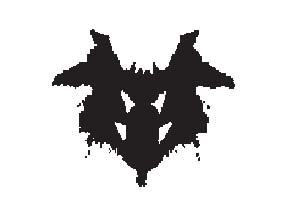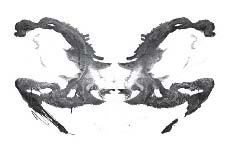Lesson 4 - Assessment and the DSM-V
Testing
Behavioural observations and interviews are direct attempts to determine a patient’s attitudes and problems. Tests, on the other hand, are a more indirect (and often more objective) method of assessing characteristics. There are two types of tests most commonly used by psychologists: psychological tests and neuropsychological tests. They are used to determine cognitive, emotional, or behavioural responses that might be associated with specific disorders. The first category, psychological, includes tests of intelligence and personality. Intelligence tests are in many different forms and measure many aspects of cognitive functioning. Most intelligence tests take a long time to administer, score, and interpret. In many cases, knowing a patient’s intelligence quotient (IQ) is not required for successful treatment; thus, the financial cost of administering the test is simply too great and the test is not administered.
Ink Blot Examples

 Personality tests can be grouped
Personality tests can be grouped  into projective and objective tests. Projective tests are unstructured. They are based on the theory that people are not always aware of their feelings and, if given the opportunity, will project their feelings onto other objects, situations, or people. One famous projective test is the Rorschach Inkblot Test designed in 1911 by Swiss psychiatrist Hermann Rorschach. Originally designed to study perception, the Inkblot test was later used to study psychological disorders. Unfortunately, this test has limited reliability and validity. For example, if two psychologists were asked to make a conclusion based on the results of an Inkblot test for the same patient, they may not agree and they would not come to the same conclusions.
into projective and objective tests. Projective tests are unstructured. They are based on the theory that people are not always aware of their feelings and, if given the opportunity, will project their feelings onto other objects, situations, or people. One famous projective test is the Rorschach Inkblot Test designed in 1911 by Swiss psychiatrist Hermann Rorschach. Originally designed to study perception, the Inkblot test was later used to study psychological disorders. Unfortunately, this test has limited reliability and validity. For example, if two psychologists were asked to make a conclusion based on the results of an Inkblot test for the same patient, they may not agree and they would not come to the same conclusions.
The Thematic Apperception Test (TAT) is similar to the Rorschach Inkblot test. This test was developed in 1935 by Morgan and Murray of the Harvard Psychological Clinic. During testing, patients are shown cards with simple pictures on them. They are then asked to make up stories. The TAT generally requires much time to administer and has, like many other tests of this type, low reliability, questionable validity, and standardization problems. In short, these types of tests cannot predict psychopathology.
Objective tests, unlike projective tests, are structured. They typically use questionnaires, inventories, or rating scales to help assess personality. One well-known test in this category is the Minnesota Multiphasic Personality Inventory (MMPI). Developed in 1943 by Hathaway and McKinley, the MMPI continues to be widely used in many countries. This test asks over 500 questions and uses 10 clinical scales, 4 special scales, and 4 validity scales. The validity scales are aimed at identifying faking – the difference between people who do have psychological illness and the ones who pretend to have psychological illness. The Lie scale, for example, measures the tendency of people to claim excessive virtue -- the tendency of wanting to present an overall favourable image. The Infrequency scale measures a tendency to claim psychological problems falsely. All tests have shortcomings, however, and the original MMPI was criticized for its sexist wording, cultural insensitivity, and poor sample selection for its initial standardization. As a response to the criticism, the MMPI-2 was created in the 1980s. The test now has updated language and improved reliability and validity.